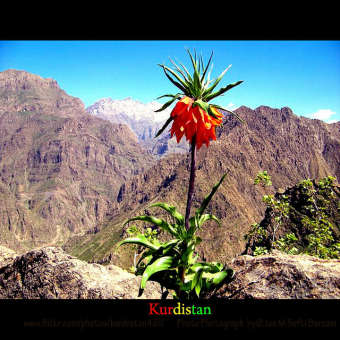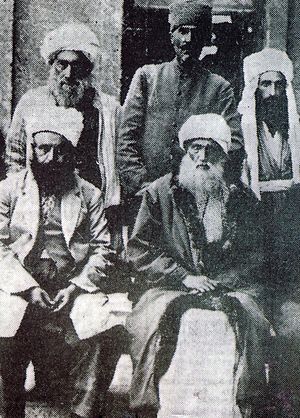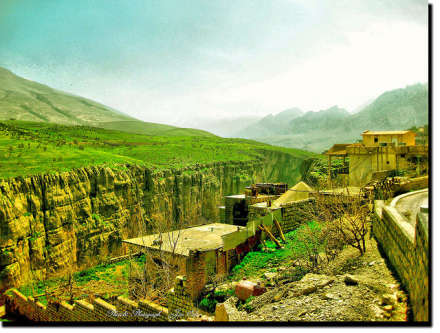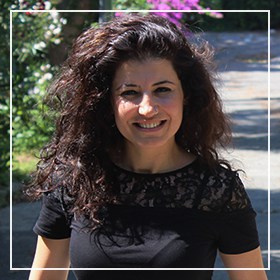The lack of a sovereign entity undoubtedly distinguishes the Kurdish diaspora from other state-bound diasporas, and Kurds are certainly to be included in the ‘stateless diasporas’ category. The stateless and divided Kurdish ‘territorial minority’ forms a diaspora (extra-territorial minority) consisting of immigrants and refugees from four ‘countries of origin’ [Iraq, Iran, Syria and Turkey], spread throughout many nation states (Emanuelsson 2005: 20). Nor can the major role played in Kurdish history by forced migration be ignored. In recent years large numbers of people have fled from Kurdistan, and Kurds now make up a broad range of diasporic communities (1) dispersed around the world (2). This is one reason why estimates of the number of Kurds outside Kurdistan are imprecise. In 1992, van Bruinessen estimated that a quarter to a third of all Kurds were living outside Kurdistan, and that only a minority of them were likely ever to return (1992b: 66).
Refugees from Turkey constitute the majority of Kurds in Europe, at a rate of approximately 80 to 85 per cent (Wahlbeck 2001: 73–99); substantial numbers are to be found in Europe and the US, and there are also indigenous Kurdish populations in Armenia, Azerbaijan, Georgia and Turkmenistan (Nezan 1993) (3). Kurdish diaspora numbers include refugees, migrants, and second and third-generation members of the diasporic communities, and the figures keep changing. Since the displacement early in the twentieth century, the extent of migration has increased further. In 1980, Kurds fled from the military takeover in Turkey, and later from the armed conflict and continuous human rights violations that followed (Emanuelsson 2005: 84). During the 1990s the number of Kurdish refugees from other states increased drastically because of escalating suppression and conflict between these states and the Kurds (van Bruinessen 2000: 10–12, Wahlbeck 2001: 74). As a result, there has been some very important research carried out on Kurdish diaspora issues, including that by Wahlbeck (1999), Emanuelsson (2005), Alinia (2004) and Østergaard-Nielsen (2006), as well as chapters or articles by Faist (1999), van Bruinessen (2000), and Hassanpour (2003b). Each work discusses the Kurdish diaspora from a different perspective.
For Kurds, forced exile becomes essential to the heightened sense of longing for ‘homeland’ and is central to the understanding of the Kurdish diaspora. Kurds who are legally accepted in the host country are tied to each other as members of the same community through various networks, such as associations, community centres and foundations that link them with their real and ‘imaginary’ ‘homeland’.
It is also significant to note that apart from the migration of Kurds to European countries as a result of economic and political factors, forced migration within Turkish Kurdistan has also had a significant impact on their geographical distribution. Internal migration in the Kurdish provinces during the 1970s occurred because of economic factors (Wedel 2000: 182), whereas the migrations of the 1980s and 1990s happened mainly for political reasons, with thousands of Kurdish villages evacuated or demolished under the Emergency Decree policies of the Turkish State.
While some Kurds migrated to other Kurdish urban centres (mainly Diyarbakir, Urfa and Van) the majority settled down in various metropolitan cities of Turkey, mainly Istanbul, Ankara, Izmir and Mersin (4).
Regarding the forced migrations, van Bruinessen (2000: 79) points out that the ‘first deportations were simply reprisals against rebellious tribes. In later years, deportations became part of the concerted effort to assimilate the Kurds’, a view supported by other researchers (Jongerden 2001, 2007, Besikci 1977). Some years since the criteria and conditions related to EU accession obliged the Turkish government to lift the state of emergency, the Turkish state has begun to favour the return of Kurdish villagers under village-town projects, while pressure from the Council of Europe through the Law on Compensation for Damage arising from Terror has created the possibility of full compensation for the villagers for the loss of lands and possessions (Claridge and Linzey 2005). Despite these policies, however, the resettlement of evacuated villages is considered to have failed to restore damaged and destroyed structures in villages (Human Rights Watch Report 2005, KHRP Legal Review 2005).  Kurds are increasingly characterised by exile, migration and diaspora; thus, the displacement from ‘homeland’ has become a part of Kurdish identity. Akkaya notes that ‘diasporic experience has allowed the Kurds in diaspora to have multiple identities rather than one based on a very strong reference to “the homeland”’ (2011: 8). Kurdish diasporas have thus contributed to the reproduction and articulation of a collective and trans-state Kurdish identity (Alinia 2004, Hassanpour and Mojab 2005, Wahlbeck 1999, van Bruinessen 1999, Khayati 2008, Akkaya 2011).
Kurds are increasingly characterised by exile, migration and diaspora; thus, the displacement from ‘homeland’ has become a part of Kurdish identity. Akkaya notes that ‘diasporic experience has allowed the Kurds in diaspora to have multiple identities rather than one based on a very strong reference to “the homeland”’ (2011: 8). Kurdish diasporas have thus contributed to the reproduction and articulation of a collective and trans-state Kurdish identity (Alinia 2004, Hassanpour and Mojab 2005, Wahlbeck 1999, van Bruinessen 1999, Khayati 2008, Akkaya 2011).
The interaction between ‘homeland’ and ‘diaspora’, which is also central to the issue of diaspora, is very influential within Kurdistan, as well as in the varied contexts within which Kurds are living. As the idea of ‘home-land’ for Kurds has been a contested and evolving notion, the ideological notions of Kurds in the ‘homeland’ affect Kurds in the diaspora, and vice versa. Van Bruinessen (1992, 2000) asserts that the awareness of Kurdistan as the homeland of the Kurds has been strengthened in exile due to the increased flow of modern ideas, freedom of expression, a safe distance from the region of origin and, eventually, the political mobilisation of Kurdish guest-workers and their descendants by Kurdish refugees. Many Kurds from Turkey came to the West as immigrant workers in the 1960s and 1970s (Kreyenbroek 1990: 56). In that context, we can see a shift of Kurmanji literary activities to Western Europe. Exclusively, Kurds from Turkish Kurdistan have managed to promote the Kurmanji dialect and develop literature in Kurmanji. ‘As part of their policy of promoting the cultural development of the immigrant communities, the Swedish authorities allot their Kurdish residents a relatively large publishing budget’ (Allison & Kreyenbroek 1996: 26).
Kurdish publishing houses in Sweden have taken the lead in encouraging many Kurdish intellectuals to write in their own mother tongue. ‘Press freedom and state subvention of migrants’ cultural activities enabled the intellectuals to publish journals and books in Kurdish.’ Kurdish ‘was developed into a modern literary language for political and intellectual discourse’ (van Bruinessen 1992: 66).
The first Kurdish Cultural Institute, which was founded in France, made remarkable contributions to the promotion of Kurdish culture and literature. The institute has organised biannual seminars at which Kurdish intellectuals and writers gather together and discuss the problems of the language on the path of modernisation. Likewise, various cultural institutions, community centres and foundations in the capitals of European countries have organised language courses in order to teach Kurdish and have supported the publication of Kurdish journals, magazines and books. In this respect, Sweden is another important host country for Kurds, many from Iraq and Iran, and many of whom are politically active intellectuals (Schmidinger 2010). It is clear that the structure of Kurdish communities can differ from one European country to another; thus it is claimed that Kurdish migrants in Germany are very well organised politically (see, for example, Emanuelsson 2005, Akkaya 2011). The Kurds in Sweden are socially and politically diversified, and since they live in the more favourable Swedish political environment, they maintain a diaspora discourse that is both flexible and more highly developed (Khayati 2008).

The Kurdish language, which is the cornerstone of the cultural identity of the Kurds, becomes the vehicle of literary expression and cultural articulation in the diaspora, since for many years Kurdish intellectuals and writers expressed themselves in the official language of the states in which they lived due to the long-lasting ban on Kurdish. It is, therefore, not surprising that one of the most significant contributions of the Kurdish diaspora is the revival of Kurdish, mainly Kurmanji, through literature. It is crucial to note that many literary works have been published outside Kurdistan. After the Sheikh Said and Xoybûn (Khoybun) uprisings, many intellectuals and writers were obliged to choose exile. Celadet Elî Bedirxan, Kamuran Elî Bedirxan, Cegerxwîn, Nuredin Zaza, Qedrîcan, Reşîde Kurd and Osman Sebrî contributed to modernising the language and developing a Kurdish prose tradition in exile. In addition, when considering Kurdish diasporan literature, attention should be given to the contribution of Yezidi Kurds who lived in Georgia, Azerbeijan and Armenia during the Soviet period. Despite the oppression and hard conditions under Stalin, writers and intellectuals such as Erebê Şemo, Eliyê Evdirehman, Heciyê Cindî and Emîne Evdal played an important role in Kurdish literature and in the emergence of Kurdish novelistic discourse. Thus, it should be noted that Kurdish novelistic discourse owes much to Kurdish intellectuals and writers of the Former Soviet Union (FSU), who made a substantial contribution to the development of the Kurmanji dialect and thereby to the emergence of the Kurdish novel. It is useful to give a brief description of the situation of the Kurdish intelligentsia in the USSR and its influence on Kurdish literature and publications. ‘Although the population of Kurds in the Soviet Union was smaller than that of Turkey, Iran, Iraq and Syria, the number per head of the population was much higher than in any of these countries’ (Hassanpour 1996: 70). During the 1920s Kurds were regarded as constituting a distinct nation, and this played a part in the enhancement of Kurdish education and literary activities. Former Soviet Kurds obtained a written form of their mother tongue after the 1917 Revolution, and first began writing Kurdish using the Armenian alphabet during the 1920s. In 1927, they shifted to the Latin alphabet, with improvements by Aisor Margulov and Erebê Şemo, until 1945 when the Cyrillic alphabet was imposed on them. At present Kurds in the FSU write using both Cyrillic and Latin forms. This level of literacy enabled the emergence of a striking number of writers ‘engaged in important literary and social-political activities including the creation of a literary language that is an instrument of social progress and communist education among this minority people’ (Vanly 1992: 210).
The first school textbooks to be written in Kurmanji were produced, and the principal steps towards modern prose writing were taken, in Soviet Armenia (Leezenberg 2011: 89), while the first Kurdish novel, Şivanê Kurmanca (The Kurdish Shepherd) by Erebê Şemo (1898-1978), which was based on the life of its author, was first published in Yerevan in 1935 (6).
 Şemo’s other novels are also among the first Kurdish novels. Kurdê Elegozê (The Kurds of Elegoz) is a sequel to Şivanê Kurmanca. Berbang (1958) is a revised version of Şivanê Kurmanca. Jiyana Bextewar (Happy Life, 1969) is based on the experience of Kurds who left their lands to escape from the massacres by the Ottomans and migrated to the Caucasus, and their new settlement in these lands. His novel Dimdim (1966) is based on the epic of the same name. In this novel, Şemo tells of the socio-political conditions of the period, the struggle within Castle Dimdim through the eyes of leader Xanê Lepzerîn. Hopo (1969) is based on the period after the revolution. In the novel, the folkloric way of narration and the influence of techniques of the oral tradition are in the foreground. Eliyê Evdirehman’s Xatê Xanîm (Lady Xate, 1959) and Dê (Mother, 1965), Heciyê Cindî’s Hewarî (Cry, 1967) and Gundê Mêrxasa (The Village of the Courageous, 1968), and Seîdê Îbo’s Kurdên Rêwî (Traveller Kurds, 1981) are also on the list of early Kurdish novels published in the USSR. Eliyê Evdirehman’s Ser Çiya da (War on the Mountains) is based on the war on Mount Ararat. The protagonist of the novel is Sheikh Zahir, who is the leader of the Khoybun (Xoybûn) uprising. The novel draws a portrait of the Khoybun uprising and the political conditions of this period. Heciyê Cindî (1908-90), who was Yazidi in origin, had to migrate to the former Soviet Union in 1918 due to oppression by the Turkish state. His novel Hewarî (Cry) was first published in 1967 in Yerevan. It was re-published in Diyarbakir in 2008 by Lîs publishing house. With his analytical and observant style, he concentrates on the events of 1915. It is important to mention that Kurdish literature, especially the genre of the novel, was developed mainly in the diaspora during the 1980s, primarily in Sweden and Germany. In this regard, Mehmed Uzun, Firat Cewerî, Mehmet Emîn Bozarslan and Bavê Nazê contributed to the enrichment of Kurmanji and enabled Kurdish (Kurmanji) in its written form to reach many more speakers. Certainly, the struggle of Kurdish intellectuals and writers from Turkish Kurdistan in the diaspora to promote Kurdish language and literature has been to the benefit of novelistic discourse, and Mehmed Uzun (1953-2006) and Mahmut Baksî (1944-2000), who were in exile in Sweden for many years, can be considered to be the most productive novelists from Turkish Kurdistan. Uzun’s Mirina Kalekî Rind (The Death of Old Rind, 1987) and Siya Evînê (In the Shadow of Love, 1989), and Baksî’s Gundikê Dono (Dono’s Village, 1988) and Hêlîn (Helin, 1984), were published in the late 1980s. Kurdish publishing houses in Europe include Nûdem, Roja Nû, Orfeus, Apec, Helwest, Sara, Welat, Pelda, Jîndan, Newroz and Kurdistan.
Şemo’s other novels are also among the first Kurdish novels. Kurdê Elegozê (The Kurds of Elegoz) is a sequel to Şivanê Kurmanca. Berbang (1958) is a revised version of Şivanê Kurmanca. Jiyana Bextewar (Happy Life, 1969) is based on the experience of Kurds who left their lands to escape from the massacres by the Ottomans and migrated to the Caucasus, and their new settlement in these lands. His novel Dimdim (1966) is based on the epic of the same name. In this novel, Şemo tells of the socio-political conditions of the period, the struggle within Castle Dimdim through the eyes of leader Xanê Lepzerîn. Hopo (1969) is based on the period after the revolution. In the novel, the folkloric way of narration and the influence of techniques of the oral tradition are in the foreground. Eliyê Evdirehman’s Xatê Xanîm (Lady Xate, 1959) and Dê (Mother, 1965), Heciyê Cindî’s Hewarî (Cry, 1967) and Gundê Mêrxasa (The Village of the Courageous, 1968), and Seîdê Îbo’s Kurdên Rêwî (Traveller Kurds, 1981) are also on the list of early Kurdish novels published in the USSR. Eliyê Evdirehman’s Ser Çiya da (War on the Mountains) is based on the war on Mount Ararat. The protagonist of the novel is Sheikh Zahir, who is the leader of the Khoybun (Xoybûn) uprising. The novel draws a portrait of the Khoybun uprising and the political conditions of this period. Heciyê Cindî (1908-90), who was Yazidi in origin, had to migrate to the former Soviet Union in 1918 due to oppression by the Turkish state. His novel Hewarî (Cry) was first published in 1967 in Yerevan. It was re-published in Diyarbakir in 2008 by Lîs publishing house. With his analytical and observant style, he concentrates on the events of 1915. It is important to mention that Kurdish literature, especially the genre of the novel, was developed mainly in the diaspora during the 1980s, primarily in Sweden and Germany. In this regard, Mehmed Uzun, Firat Cewerî, Mehmet Emîn Bozarslan and Bavê Nazê contributed to the enrichment of Kurmanji and enabled Kurdish (Kurmanji) in its written form to reach many more speakers. Certainly, the struggle of Kurdish intellectuals and writers from Turkish Kurdistan in the diaspora to promote Kurdish language and literature has been to the benefit of novelistic discourse, and Mehmed Uzun (1953-2006) and Mahmut Baksî (1944-2000), who were in exile in Sweden for many years, can be considered to be the most productive novelists from Turkish Kurdistan. Uzun’s Mirina Kalekî Rind (The Death of Old Rind, 1987) and Siya Evînê (In the Shadow of Love, 1989), and Baksî’s Gundikê Dono (Dono’s Village, 1988) and Hêlîn (Helin, 1984), were published in the late 1980s. Kurdish publishing houses in Europe include Nûdem, Roja Nû, Orfeus, Apec, Helwest, Sara, Welat, Pelda, Jîndan, Newroz and Kurdistan.
The political situation of the Kurds and the controversial position of Kurdistan have led scholars and researchers to engage mainly with the political and historical aspects of the Kurds, and even though research on Kurdish literature has developed considerably in recent years, insufficient attention has been paid to the Kurdish novelistic discourse in particular.
On the other hand, due to the less restricted conditions prevailing in Iraqi Kurdistan, both literature and literary research have expanded significantly. Although the future seems to be quite promising at the moment in relation to the Kurdish literary world in Turkish Kurdistan and in the diaspora, and despite the growing number of fictional and non-fictional literary works becoming available, Kurdish literature, and in particular the novelistic discourse, still remains to be studied.
(1) The term ‘Kurdish diasporic community’ is commonly used by researchers and scholars (Minoo Alinia, ‘Spaces of diasporas’; Ibrahim Sirkeci, The Environment of Insecurity in Turkey and the Emigration of Turkish Kurds to Germany (New York, 2006); Nevzat Soguk, ‘Transversal communication, diaspora, and the Euro-Kurds’, Review of International Studies 34/1 (2008), pp. 173-92) who specialise in the Kurdish diaspora. I also prefer to use this term as it includes all sorts of Kurdish migrants such as refugees, workers, exiles etc. By diasporic novels, I mean the novels written by all types of Kurdish migrants in the diaspora.
(2) By ‘Kurdish diaspora’, I mean Kurdish communities and settlements located in the West, but the term does not apply to all Kurds who live outside the territory of Kurdistan (e.g. Kurds living in Khurasan, Istanbul, Baghdad, Tehran, Damascus, Armenia and so forth). Currently, the Kurdish diaspora is scattered throughout various European countries including Germany, France, Belgium, Norway, Sweden and the Netherlands. For the Kurds from Turkish Kurdistan, Germany became the leading host country. However, Sweden leads in terms of the number of Kurdish publications, mainly novels.
(3) There are no official figures for the number of Kurds in Europe. As Ayata points out, the actual size of the Kurdish diaspora ‘remains an enigma [ … ] no recent reliable census of the Kurdish diaspora in Europe has been carried out.’ Bilgin Ayata, ‘The politics of displacement: a transnational analysis of the forced migration of Kurds in Turkey and Europe’, unpublished PhD thesis, Johns Hopkins University (Baltimore, MD, 2011), p.143. However, the most widely accepted estimates suggest there are that some ‘850,000 Kurds in Western Europe, of which 500,000–600,000 live in Germany’ (Bahar Baser, Kurdish Diaspora Political Activism in Europe with a Particular Focus on Great Britain (Berlin, 2011), p.8). The socio-cultural and political conditions of Kurdish migrants differ from one European country to another. For example, although the Kurdish Institute in Paris, founded in 1983, has contributed to the development of the Kurdish language, there have as yet been no novels in Kurmanji (by Kurds from Turkish Kurdistan) written in France. The United Kingdom has hosted an increasing number of Kurds since the 1990s; however, despite well-organised associational networks with a great range of political and cultural activities, studies or research on Kurdish language or literature do not go beyond individual efforts. As noted earlier, Sweden is the leading host country in relation to the number of publications and literary advances, due to generous state contributions, thanks to which most of the diasporic novels have been published in Sweden. In addition, there are four novelists living in Germany, Zeynel Abidîn, Fêrgîn Melîk Aykoç and Diyar Bohtî, who have all produced several novels, and Jîr Dilovan, who has one novel. While Medenî Ferho and Reşat Akgül live in Belgium, Rıza Çolpan lives in Australia. The novelists living in Sweden are from the generation born between 1944 and 1963. It can be said that compared to the generation that migrated during the 1980s (almost all the diasporic novelists examined in this book), members of the younger migrant generation either do not produce literary works, or prefer to engage in more academic or scholarly studies. The easing of censorship of Kurdish publications in Turkish Kurdistan is also a factor behind the reduction in the diaspora’s responsibility for preserving the Kurdish language.
(4) For more, see Joost Jongerden, The Settlement Issue in Turkey and the Kurds: an Analysis of Spatial Policies, Modernity and War (Leiden, 2007), and two reports for the Kurdish Human Rights Project (KHRP): Lucy Claridge and Sharon Linzey, The Status of Internally Displaced Kurds in Turkey and Compensation Rights (London, 2005) and Mark Müller and Sharon Linzey, The Internally Displaced Kurds of Turkey: Ongoing Issues of Responsibility, Redress and Resettlement (London, 2007).
(5) Kurdish literature and press have mainly been developed in exile. For example, as well as the first Kurdish journal Kurdistan (1898), the seminal literary and cultural journal Roja Nû (The New Day) was published in Beirut, between 1943 and 1946, by Kamuran Bedirkhan (1895–1978), who is also originator of the Latinised Kurdish alphabet, and Ronahî (The Light, 1942-5) and Hawar (The Cry, 1932–45) were published by Celadet Bedirkhan (1893–1951) in Damascus. These journals contributed significantly to the development of modern Kurdish literature in the diaspora, as did the literary magazine Nûdem (New Time, 1992–2002), which was published in Kurmanji, with the support of writer and editor Firat Cewerî.
(6) Opinions differ about the publication date of Şivanê Kurmanca. Some scholars assert that it was published in 1927; however, Ahmadzadeh (2003) and Aydogan (2011), both confirm the date as 1935.

Bibliography
Akkaya, Ahmet Hamdi, ‘Kurdish diaspora: creating new contingencies in transnational space’, paper presented at 4th Global Conference on Interculturalism, Meaning and Identity, Prague, 11 March 2011.
Alinia, Minoo, ‘Spaces of diasporas, Kurdish identities, experiences of otherness and politics of belonging’, unpublished PhD thesis, Gothenburg University (2004).
Emanuelsson, Ann C., Diaspora Global Politics: Kurdish Transnational Networks and Accommodation of Nationalism (Göteborg, 2005).
Beşikçi, Ismail, Kürtlerin ‘mecburi iskan’ı (Ankara, 1977).
Claridge, Lucy, and Sharon Linzey, The Status of Internally Displaced Kurds in Turkey and Compensation Rights (London, 2005) (Report for the Kurdish Human Rights Project (KHRP)).
Faist, Thomas, ‘Developing transnational social spaces: the Turkish-German example’, in Ludger Pries (ed.), Migration and Transnational Social Spaces (Aldershot, 1999).
Hassanpour, Amir and Shahrzad Mojab, ‘Kurdish diaspora’, in Melvin Ember, Carol R. Ember and Ian Skoggard (eds), Encyclopedia of Diasporas: Immigrant and Refugee Cultures Around the World (New York, 2005).
Human Rights Watch, World Report: Events of 2004 (New York, 2005).
Jongerden, Joost, ‘Resettlement and reconstruction of identity: the case of the Kurds






